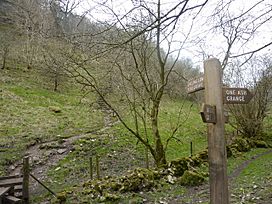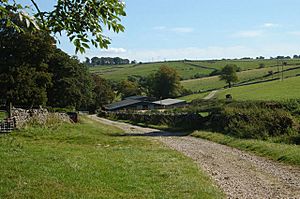Cales Dale facts for kids
Quick facts for kids Cales Dale |
|
|---|---|

Limestone Way crossing in Cales Dale
|
|
| Floor elevation | 200 metres (656 ft) |
| Length | 2 kilometres (1.2 mi) |
| Width | 130 metres (427 ft) |
| Depth | 60 metres (197 ft) |
| Geography | |
| Location | Derbyshire, England |
| Population centers | Monyash and Youlgreave |
| Rivers | Tributary of River Lathkill |
Cales Dale is a beautiful, short valley located in the amazing Peak District of England. You can find it near the village of Monyash in Derbyshire, close to the start of Lathkill Dale.
Contents
Discovering Nature in Cales Dale
Cales Dale is part of the Derbyshire Dales National Nature Reserve. This means it's a special place protected for its amazing natural environment and wildlife. Many visitors come here to enjoy the outdoors.
A Home for Wildlife
Natural England helps manage this reserve. It includes five different valleys in the White Peak area. These are Lathkill Dale, Cressbrook Dale, Hay Dale, Long Dale and Monk’s Dale.
Cales Dale is also part of the Lathkill Dale Site of Special Scientific Interest (SSSI). This area is famous for its wide variety of wildflowers. You can find beautiful orchids and the rare plant called Jacob's ladder here.
The dale is also home to many different butterflies. It has old woodlands and is a great place to spot birds of prey. You might also see dippers, woodpeckers, and even water voles. Most of Cales Dale is open for everyone to explore. This is thanks to a law called the Countryside and Rights of Way Act 2000.
Exploring History in Cales Dale
Cales Dale has a long and interesting history. People lived here many centuries ago.
Medieval Village Remains
On the north-western slopes of Cales Dale, you can see the remains of a medieval settlement. This site is so important that it's protected as a Scheduled Monument. These earthworks are what's left of a village connected to a nearby farm called One Ash Grange.
One Ash Grange was first mentioned in the Domesday Book in 1086. This was a huge survey of England ordered by William the Conqueror. Later, in the late 1100s, Cistercian monks from Roche Abbey set up the grange. They were a type of Christian religious order.
Archaeologists have found the foundations of a large building here. It was about 20 meters long and 12 meters wide. Parts of a stone cross head, from the 10th or 11th century, were also discovered nearby. You can see these pieces today at the Buxton Museum. The farmhouse, barn, and pigstyes at One Ash Grange Farm are now listed buildings. This means they are protected because of their historical importance.
Ancient Burial Mound
Above the east side of Cales Dale, there's an ancient burial mound called Calling Low bowl barrow. This mound dates back to the Bronze Age, thousands of years ago. It is also a Scheduled Monument.
In 1846, a person named Thomas Bateman excavated, or dug into, this mound. He found a stone box, called a cist, inside. This cist held a human skeleton, a sandstone sphere, and tools made of flint. These discoveries tell us about the people who lived here long ago.
Things to Do and See
Cales Dale is a great place for walking and exploring.
Walking the Limestone Way
The Limestone Way is a long-distance walking path. It crosses Cales Dale near One Ash Grange Farm. This path is popular with hikers who want to see the beautiful countryside.
Parking and Access
If you want to visit, there are places to park your car near Monyash. This is at the top end of Lathkill Dale. You can also find a car park at Moor Lane, which is closer to the village of Youlgreave.
A Famous Film Location
Did you know that Cales Dale was once a movie set? The "Battle of Wits" scene from the famous film The Princess Bride was filmed here in 1986. It's a fun fact for movie fans!


